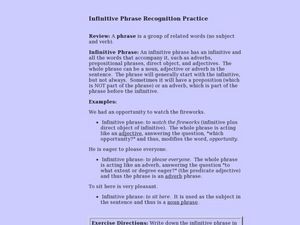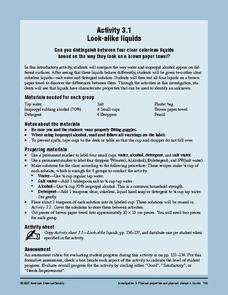Media Smarts
Tobacco Labels
Adolescents compare and assess the efficacy of tobacco product health warning labels from around the world. In groups, they invent warnings and create labels that would be effective for teens and children. Discussion covers advertising...
Curated OER
Sugar-Coating the Facts
Students explore the food industry's influence on American Student nutritional habits and analyze the nutrition charts found on food packaging. They design their own warning labels for foods targeted at Students.
Curated OER
Warning signs
Students sort and classify different attributes of warning signs, labels, and sounds. In this warning signs lesson plan, the teacher shows students different warning signs, labels, and sounds and tells students what each one means. ...
Curated OER
Read That Label!
High schoolers explore reading nutritional labels and making good food choices through simulation. They prepare and design a label for a product. In addition, they create packaging and advertising to ensure access to the population.
Curated OER
Hazardous Products Substitutes
Students investigate toxic substances. In this health lesson, students identify warning labels on common household cleaners and create a "less toxic" cleaning recipe book. Students recite a pledge to try a less toxic substitute at home.
Curated OER
Weather Wonderings
Students explore the various types of weather. They discuss the difference between tornado watches and tornado warnings. Students investigate the various types of clouds. They sketch and label the 8 different types of clouds. Students...
Curated OER
ADULT ESOL LESSON PLAN--Level 2--Health and Nutrition
Students, as they extensively review the vocabulary words on the board, examine the parts of a label and why it's so crucial to follow the directions on medicine labels to avoid reactions and the possible causing of future health issues.
Curated OER
What's Hiding in Your Home Cabinets?
Students analyze a variety of products found in their own homes to determine their toxic content. They identify words such as caution, warning or danger and relate them to their relative toxicity levels.
Curated OER
Where Do We Get Clean Water?
Students investigate the concept of a filter. They use simple supplies in order to construct one after watching a demonstration performed by the teacher. An important warning that the project water is not clean for drinking is included....
Curated OER
Solar Kit Lesson #1 Solar Cell Inquiry
Pupils use a selection of solar panels, lamps, motors, and an AA battery to get as many motors or lights to operate as they can in an allotted time period. For each successful arrangement, they draw a diagram of their setup, label the...
Curated OER
Infinitive Phrase Recognition Practice
In this infinitive phrase practice worksheet, students read an informative lesson. Students then respond to 10 questions that require them to identify the infinitive phrases in the sentences and label them as noun, adjective, or adverb.
Curated OER
Put Me in My Place: Using Alphanumeric Grids to Locate Places
Students practice locating points on a large wall grid and create and label a neighborhood map. In this geography lesson, students spell and discuss places as the teacher places them on the map. They discuss the concept of an...
Virginia Department of Education
Hurricanes: An Environmental Concern
Hurricanes, typhoons, and tropical cyclones are the same type of storm, but their names change based on where they happen. Scholars use a computer simulation to learn about hurricanes. Then they hypothesize ideas to prevent hurricanes...
Curated OER
I Oppose!--Counter-argument/Classifying
Young scholars create an effective classification and counter argument. In this counter-argument lesson, students decide upon a label for at least three types of people and then describe their groups. Young scholars describe three...
Curated OER
The human barometer
Learners read the story: 9-year-old girl dies on railway line. They engage in the 'Human Barometer': Collect a range of names of dangerous activities from the class. For example: skateboarding, waterskiing, bungee jumping, climbing,...
Curated OER
ESOL Safey and Security
Students study vocabulary words related to safety and warining signs. They write and practice saying the words. They view picture flash cards and attach different signs to the safety situations. They work in groups to create a...
Curated OER
Media Literacy
Elementary learners observe and discuss advertisements for tobacco and alcohol. They identify how advertisers place information in strategic spots and make their product look good. They choose an ad and fill out the attached form on...
Curated OER
Why Eat Organic?
Ninth graders explore the concept of organic eating. In this environmental stewardship lesson, 9th graders compare and contrast organic foods with conventional foods and discuss the benefits of eating organic foods.
American Chemical Society
Using Color to See How Liquids Combine
Blue-tinted water is added to unknown liquids that have been tinted yellow to find out how they interact. This is a memorable activity that is part of an investigation on the properties of liquids, which is part of a unit on the...
American Chemical Society
Using Chemical Change to Identify an Unknown
If you have taught the first lesson in this mini unit, learners already know that cabbage juice and vinegar cause chemical changes in some materials. Now, they get a chance to use them to compare the liquids' reactions to five known and...
American Chemical Society
Look-Alike Liquids
Here is the first of four experiments to differentiate among unknown liquids by their behaviors and properties. Pupils observe how different liquids respond to being placed on plastic and paper, and they take notes about their...
American Chemical Society
Dissolving a Substance in Different Liquids
Second of six lessons in a unit on dissolving, this one focuses on how sugar behaves in different liquids. Learners stir it into water, alcohol, and oil and make observations. This lesson can stand alone, but is best used as part of the...
American Chemical Society
Dissolving Different Liquids in Water
Not many youngsters realize that solids aren't the only materials that can possibly be dissolved in water. During this investigation, they find out that some liquids can dissolve in water as well. This is part of a unit on solubility,...
American Chemical Society
Why Does Water Dissolve Sugar?
Did you know that if you wait long enough, the M on the outside of an M and M will float to the surface when submerged in water? Learners observe the sugar coating of an M and M while it is dissolving in water. They explain how this...

























